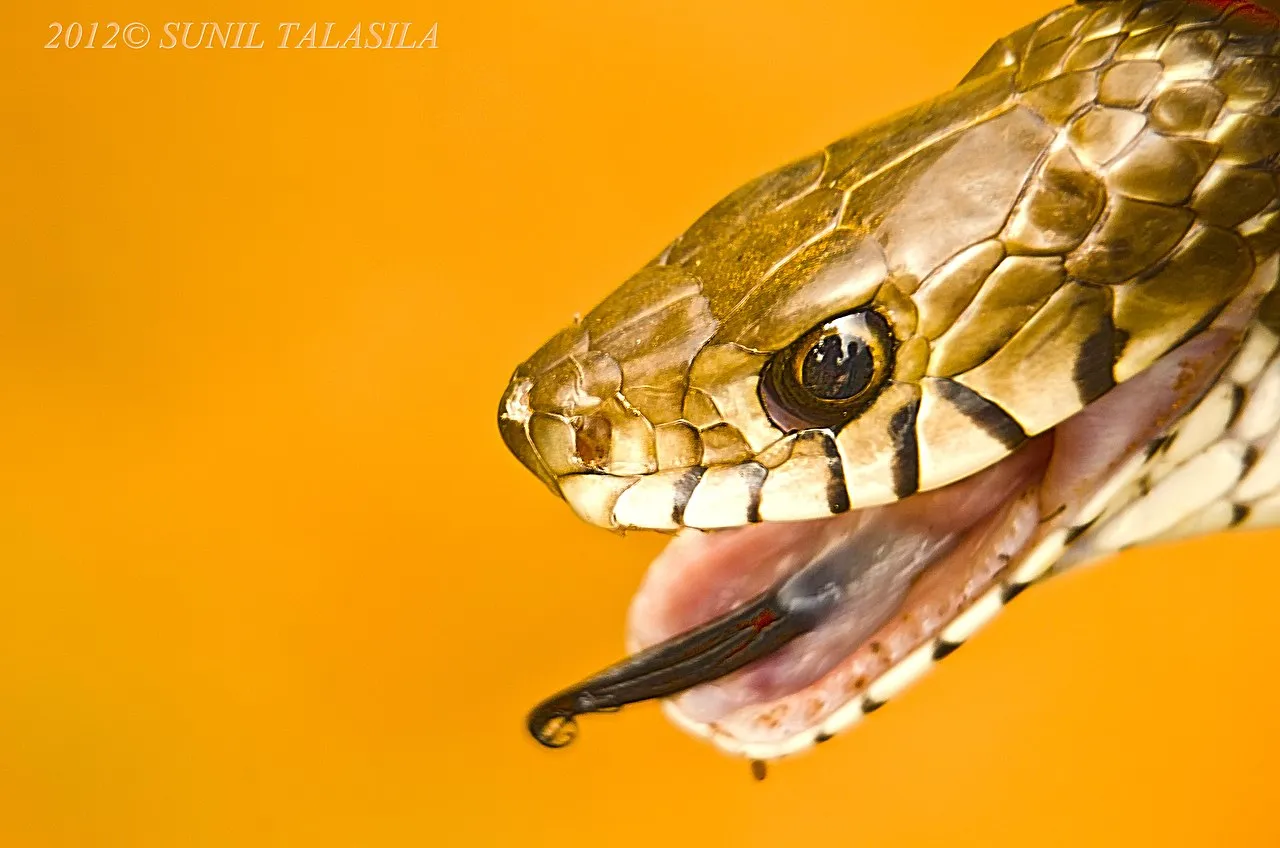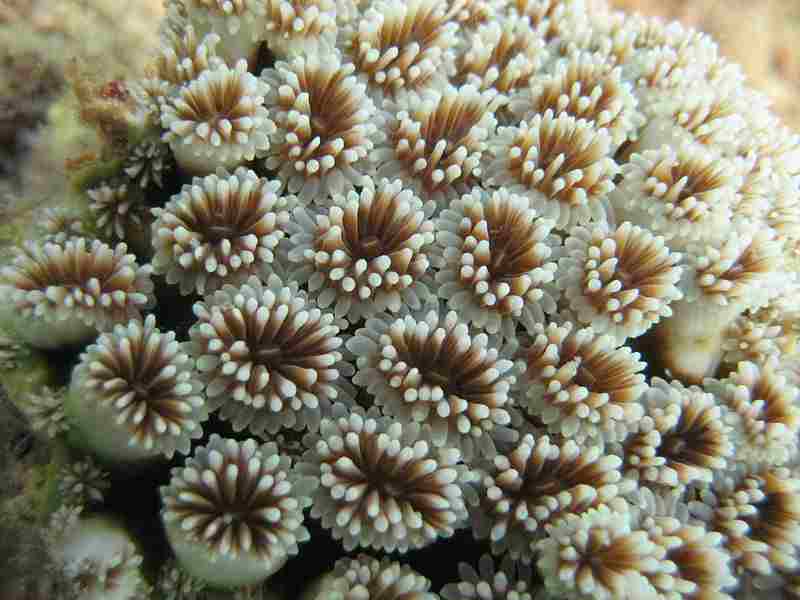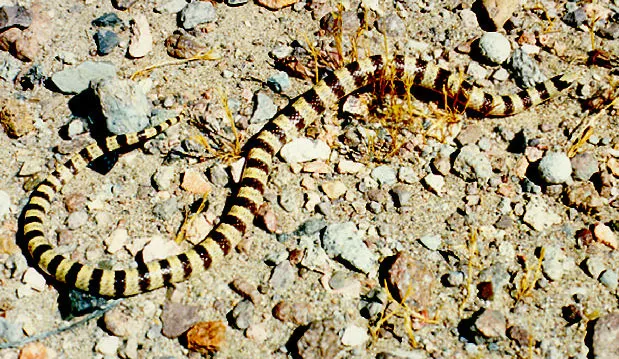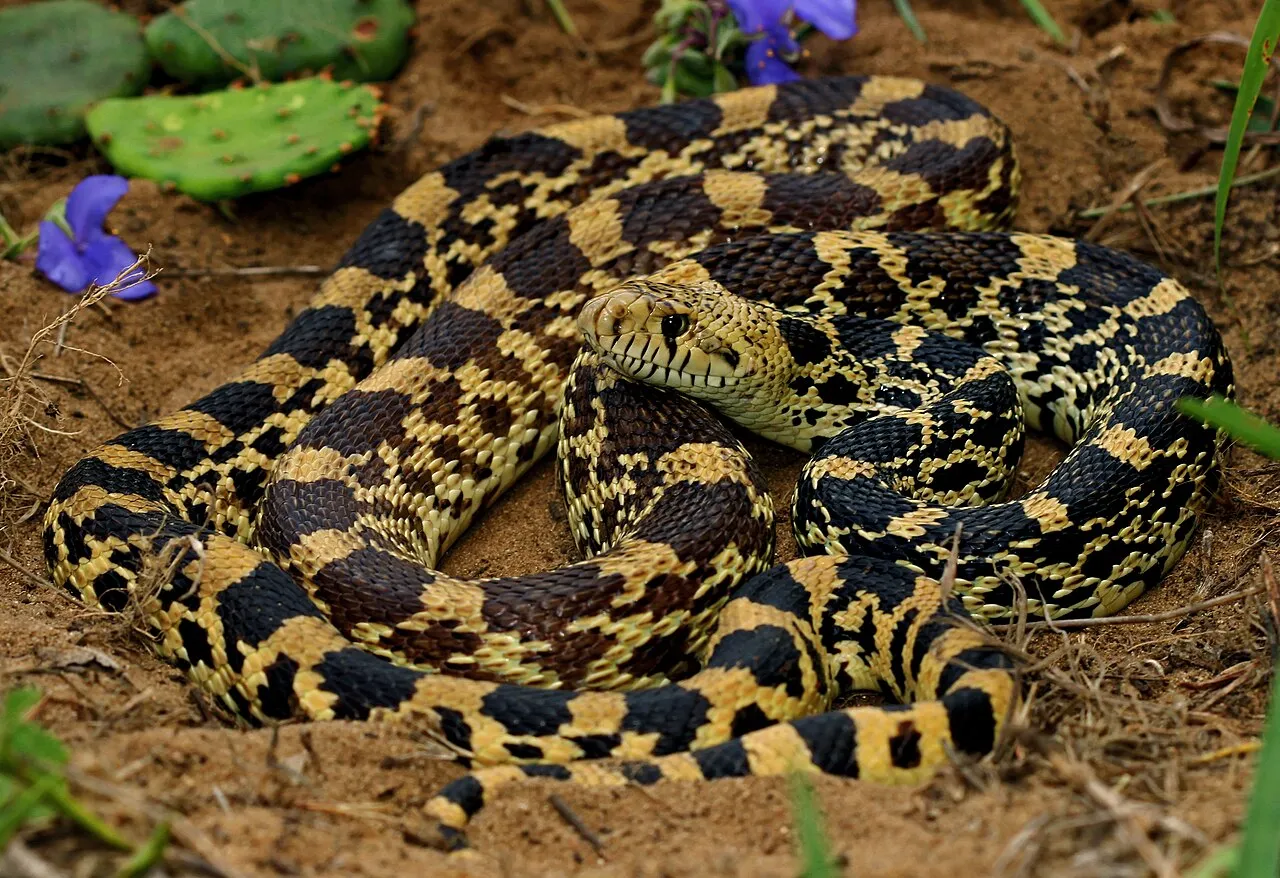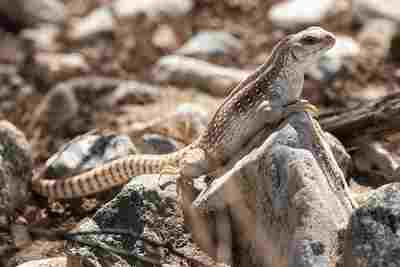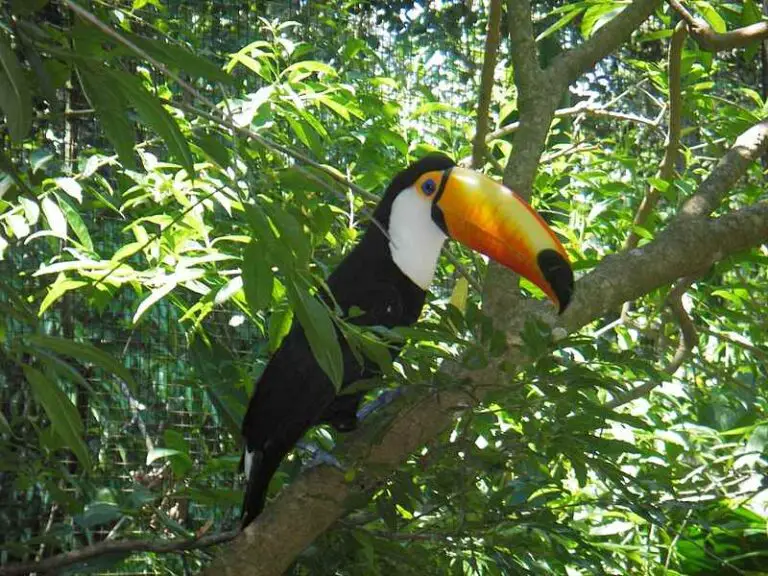27+ Snakes in New Mexico and Their Characteristics
Snakes in New Mexico include; Western diamondback rattlesnake, Black-tailed rattlesnake, Mojave green, Arizona coral snake, Ring-necked snake, Desert kingsnake, Coachwhip, Long-nosed snake, Striped whipsnake, Plain-bellied water snake, Sonora, Western terrestrial garter snake, Western hognose snake, California kingsnake, Glossy snake, Smooth green snake, Gray-banded kingsnake, Centipede snake, Trans-Pecos rat snake, Eastern racer, Texas lyre snake, Eastern massasauga, Western ribbon snake, Chihuahuan nightsnake, Bullsnake, Sonoran gopher snake, Night snake, Texas blind snake, and Great Basin gopher snake.
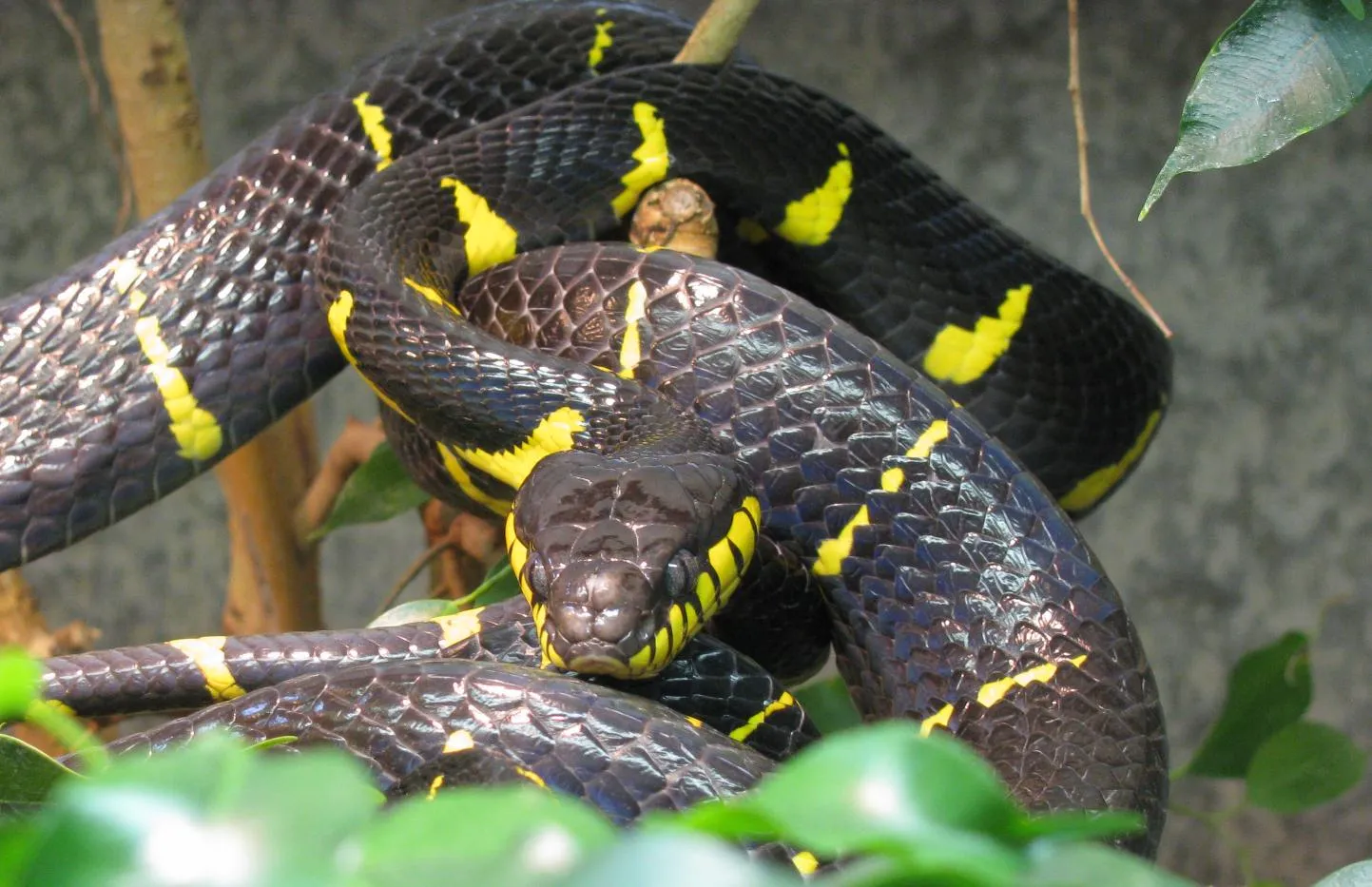
| Snake | Details |
| Western Diamondback Rattlesnake |
Scientific Name: Crotalus atrox Length: 3-5 feet Coloration: Brownish-gray with diamond-shaped markings Habitat: Desert, grassland, rocky areas
|
| Black-tailed Rattlesnake |
Scientific Name: Crotalus molossus Length: 2-3 feet Coloration: Light gray or brown with black tail bands Habitat: Desert, scrubland, rocky areas
|
| Mojave Green |
Scientific Name: Crotalus scutulatus Length: 2-4 feet Coloration: Light green with dark green or brown markings Habitat: Desert, sandy areas
|
| Arizona Coral Snake |
Scientific Name: Micruroides euryxanthus Length: 1-2 feet Coloration: Bright red, yellow, and black bands Habitat: Desert, scrubland, rocky areas
|
| Ring-necked Snake |
Scientific Name: Diadophis punctatus Length: 10-15 inches Coloration: Gray or brown with yellow or orange neck ring Habitat: Woodlands, grasslands
|
| Desert Kingsnake |
Scientific Name: Lampropeltis getula splendida Length: 3-4 feet Coloration: Black or dark brown with white or cream-colored bands Habitat: Desert
|
| Coachwhip |
Scientific Name: Coluber flagellum Length: >6 feet Coloration: Variable, often solid brown or reddish-brown Habitat: Desert, grassland, scrubland
|
| Long-nosed Snake |
Scientific Name: Rhinocheilus lecontei Length: 3 feet Coloration: Reddish-brown or pinkish-brown with black blotches Habitat: Desert, grassland
|
| Striped Whipsnake |
Scientific Name: Masticophis taeniatus Length: >4 feet Coloration: Grayish-brown with longitudinal stripes Habitat: Desert, grassland, scrubland
|
| Plain-bellied Water Snake |
Scientific Name: Nerodia erythrogaster Length: 3 feet Coloration: Olive-brown to dark brown Habitat: Rivers, streams, ponds
|
| Sonora |
Scientific Name: Sonora semiannulata Length: 2-3 feet Coloration: Light brown or grayish Habitat: Desert, grassland, rocky hillsides
|
| Western Terrestrial Garter Snake |
Scientific Name: Thamnophis elegans Length: 3 feet Coloration: Variable, ranging from greenish-gray to brown Habitat: Grasslands, woodlands, meadows
|
| Western Hognose Snake |
Scientific Name: Heterodon nasicus Length: 1-2 feet Coloration: Variable, ranging from grayish-brown to reddish-brown Habitat: Grassland, desert
|
| California Kingsnake |
Scientific Name: Lampropeltis californiae Length: 4-5 feet Coloration: Black or dark brown with white bands Habitat: Woodlands, grasslands, chaparral
|
| Glossy Snake |
Scientific Name: Arizona elegans Length: 2-3 feet Coloration: Light brown or tan with dark blotches Habitat: Desert, grassland, rocky slopes
|
| Smooth Green Snake |
Scientific Name: Opheodrys vernalis Length: 1-2 feet Coloration: Bright green with yellow or white underside Habitat: Grasslands, meadows, wetlands
|
| Gray-banded Kingsnake |
Scientific Name: Lampropeltis alterna Length: 3-4 feet Coloration: Black or dark brown with light gray or white bands Habitat: Rocky areas, deserts
|
| Centipede Snake |
Scientific Name: Tantilla spp. Length: <12 inches Coloration: Brown or gray Habitat: Desert, grassland, woodlands
|
| Trans-pecos Rat Snake |
Scientific Name: Bogertophis subocularis Length: 4-5 feet Coloration: Brown or gray Habitat: Deserts, grasslands, rocky slopes
|
| Eastern Racer |
Scientific Name: Coluber constrictor Length: >4 feet Coloration: Variable, often greenish-gray or brown Habitat: Woodlands, grasslands, fields
|
| Texas Lyre Snake |
Scientific Name: Trimorphodon biscutatus Length: 3-4 feet Coloration: Gray or brown with dark blotches Habitat: Deserts, rocky hillsides, canyons
|
| Eastern Massasauga |
Scientific Name: Sistrurus catenatus Length: 1-2 feet Coloration: Gray or brown with dark blotches Habitat: Wetlands, marshes, meadows
|
| Western Ribbon Snake |
Scientific Name: Thamnophis proximus Length: 2-3 feet Coloration: Gray or brown with three yellow or white stripes Habitat: Streams, ponds, marshes
|
| Chihuahuan Nightsnake |
Scientific Name: Hypsiglena jani Length: <2 feet Coloration: Gray or brown Habitat: Deserts, rocky slopes, woodlands
|
| Bullsnake |
Scientific Name: Pituophis catenifer sayi Length: 6 feet Coloration: Yellow or cream-colored Habitat: Grasslands, prairies, agricultural fields
|
| Sonoran Gopher Snake |
Scientific Name: Pituophis catenifer affinis Length: 6 feet Coloration: Yellow or tan Habitat: Deserts, grasslands, scrublands
|
| Night Snake |
Scientific Name: Hypsiglena torquata Length: <2 feet Coloration: Gray or brown Habitat: Deserts, rocky slopes, woodlands
|
| Texas Blind Snake |
Scientific Name: Leptotyphlops dulcis Length: <1 foot Coloration: Pinkish or purplish-brown Habitat: Deserts, grasslands, woodlands
|
| Great Basin Gopher Snake |
Scientific Name: Pituophis catenifer deserticola Length: 6 feet Coloration: Yellow or tan Habitat: Deserts, grasslands, shrublands
|
1. Western Diamondback Rattlesnake
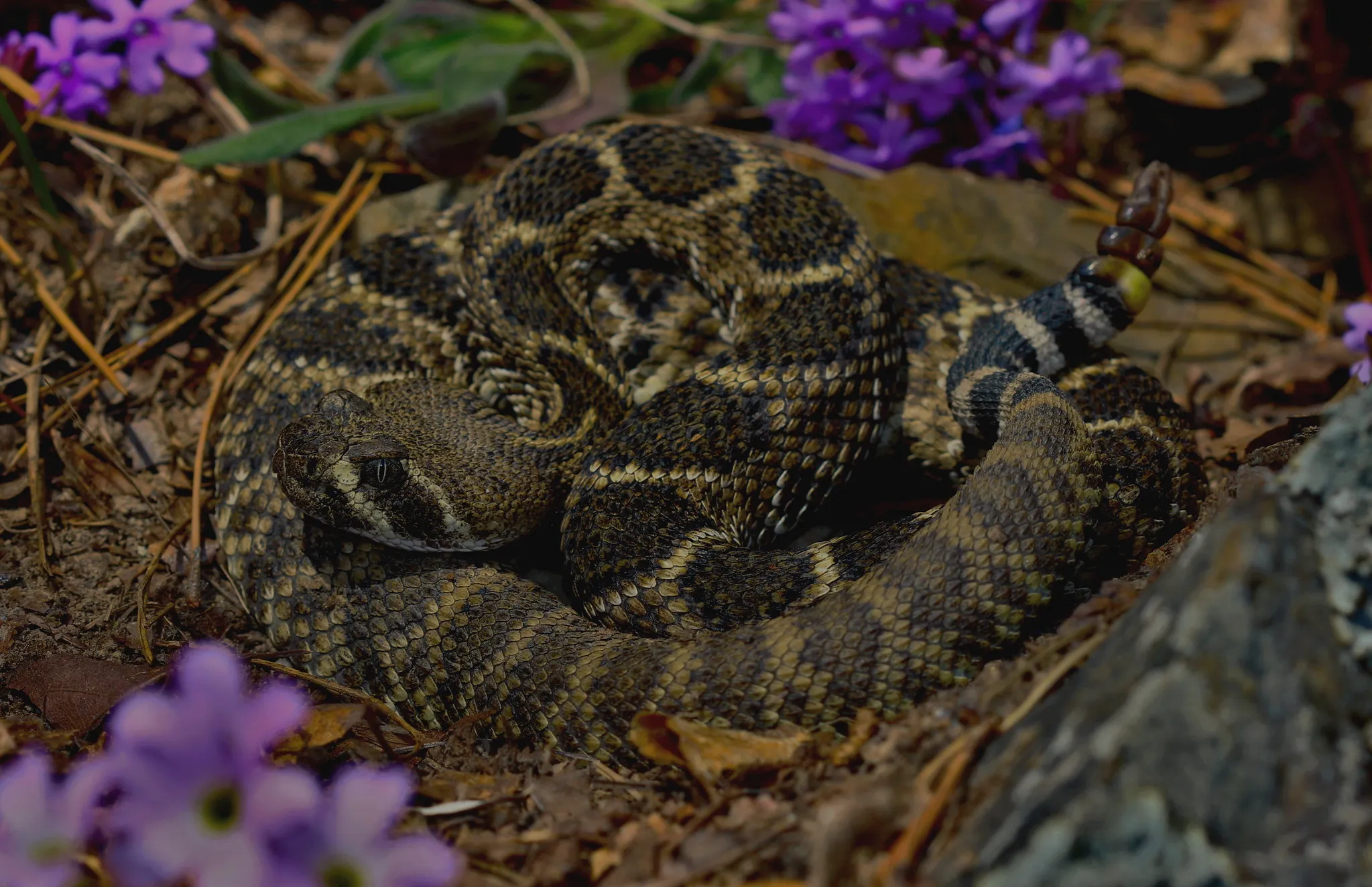
Details:
Scientific Name: Crotalus atrox
Length: Can reach up to 4-5 feet in length
Coloration: Grayish-brown with diamond-shaped patterns along its back
Venom: Possesses potent hemotoxic venom used for subduing prey
Ecological Importance:
Apex predator: Helps regulate populations of rodents and small mammals, contributing to ecosystem balance
Prey control: Feeds on rodents, which helps to prevent crop damage and reduce disease transmission
Keystone species: Plays a significant role in maintaining biodiversity and ecosystem health
Adaptations to New Mexico Environment:
Heat tolerance: Evolved to withstand the arid desert climate of New Mexico, utilizing behavioral adaptations like seeking shade during the hottest parts of the day
Camouflage: Blends into the sandy desert terrain with its coloration and pattern, aiding in hunting and avoiding predators
Water conservation: Can survive long periods without water by obtaining moisture from prey and utilizing efficient water retention mechanisms
2. Black-tailed Rattlesnake
Details:
Scientific Name: Crotalus molossus
Length: Typically 2-3 feet in length
Coloration: Grayish-brown with black tail, often with light-colored bands
Venom: Hemotoxic venom used for subduing prey
Ecological Importance:
Rodent control: Contributes to controlling rodent populations, which helps maintain ecosystem balance
Predation: Serves as prey for larger predators, contributing to food webs
Biodiversity: Plays a role in maintaining biodiversity by occupying a unique ecological niche
Adaptations to New Mexico Environment:
Thermal regulation: Able to regulate body temperature in varied desert environments through behavioral adaptations such as seeking shelter during extreme heat
Camouflage: Blends into rocky desert habitats with its coloration and pattern, aiding in hunting and avoiding predators
Water efficiency: Adapted to conserve water in arid environments by minimizing water loss through specialized skin structures and behavior
3. Mojave Green
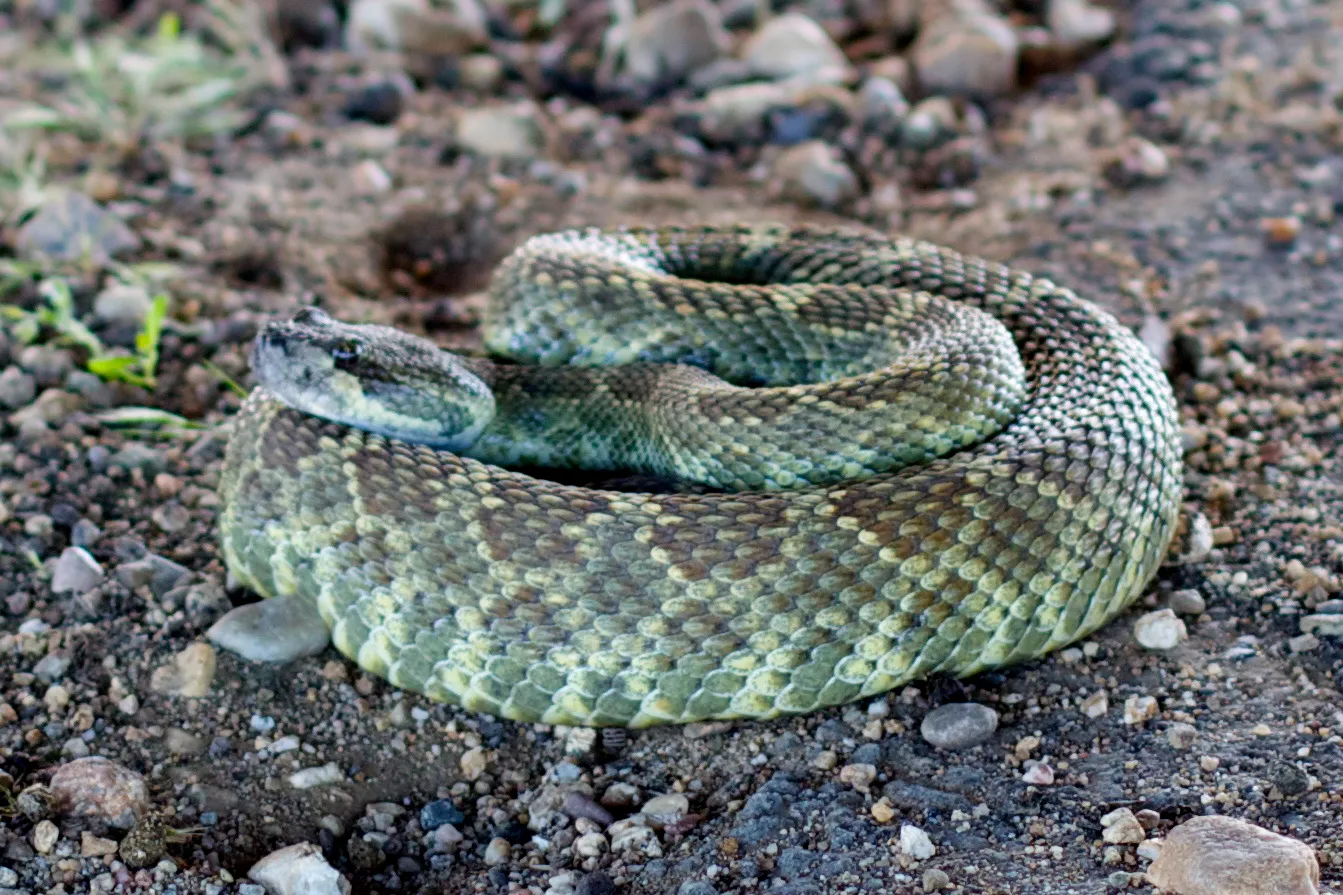
Details:
Scientific Name: Crotalus scutulatus
Length: Typically 3-4 feet in length
Coloration: Greenish-brown with diamond-shaped patterns along its back
Venom: Neurotoxic venom, one of the most potent among rattlesnakes
Ecological Importance:
Rodent control: Helps regulate rodent populations, which can otherwise damage crops and spread disease
Prey for predators: Serves as food for various predators, contributing to ecosystem dynamics
Keystone species: Plays a role in maintaining balance within desert ecosystems
Adaptations to New Mexico Environment:
Heat tolerance: Evolved to thrive in the hot, arid conditions of New Mexico, employing behavioral adaptations such as basking in the sun and seeking shade
Camouflage: Blends into desert environments with its coloration and pattern, enhancing its ability to ambush prey and evade predators
Water conservation: Can survive with limited water intake by obtaining moisture from prey and utilizing efficient water retention mechanisms
4. Arizona Coral Snake
Details:
Scientific Name: Micruroides euryxanthus
Length: Typically less than 2 feet in length
Coloration: Brightly colored with red, yellow, and black bands
Venom: Neurotoxic venom, potentially lethal to humans
Ecological Importance:
Prey control: Feeds on small reptiles and amphibians, contributing to the regulation of their populations
Predator-prey dynamics: Provides food for larger predators, contributing to energy transfer within the ecosystem
Indicator species: Presence or absence can indicate the health of ecosystems and habitats
Adaptations to New Mexico Environment:
Burrowing behavior: Often found in sandy soils, where it can burrow to escape extreme temperatures and predators
Warning coloration: Displays bright warning colors to deter potential predators, such as birds and mammals, from attacking
Seasonal activity: Adjusts activity levels based on temperature and moisture levels, remaining dormant during periods of extreme heat or cold
5. Ring-necked Snake
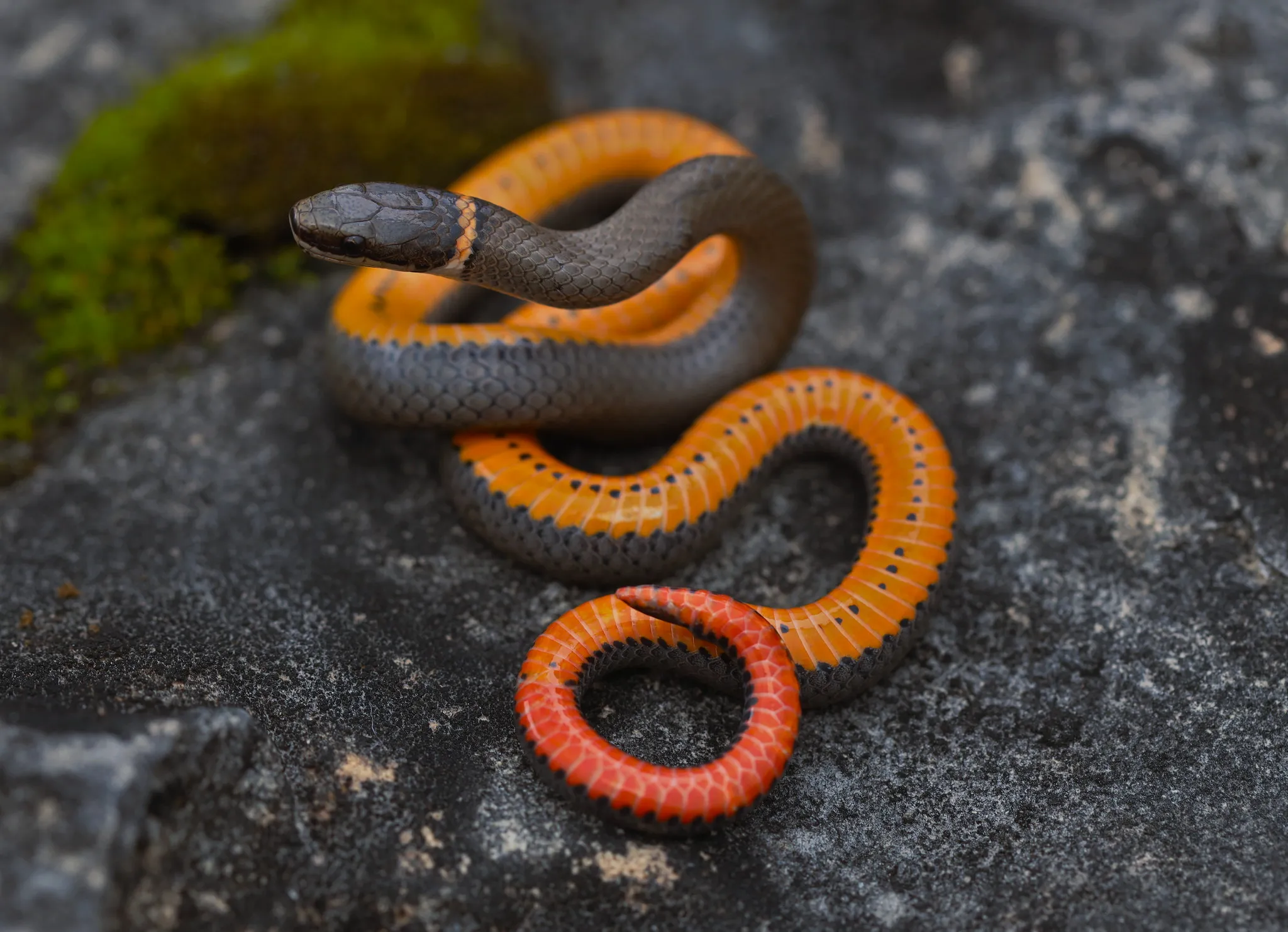
Details:
Scientific Name: Diadophis punctatus
Length: Typically 10-15 inches in length
Coloration: Grayish-black with a distinct yellow or orange ring around its neck
Venom: Mildly venomous, primarily used to subdue small prey
Ecological Importance:
Insect control: Feeds on insects, slugs, and small amphibians, helping to control insect populations
Prey for predators: Serves as prey for larger snakes, birds, and mammals, contributing to food webs
Habitat indicator: Presence can indicate the health of forested and grassland ecosystems
Adaptations to New Mexico Environment:
Nocturnal behavior: Active primarily at night to avoid predators and regulate body temperature in the hot desert climate
Burrowing: Utilizes burrows or crevices in rocks for shelter and protection from extreme temperatures
Camouflage: Blends into leaf litter and undergrowth with its coloration, aiding in hunting and avoiding predators
6. Desert Kingsnake
Details:
Scientific Name: Lampropeltis getula splendida
Length: Can reach up to 3-4 feet in length
Coloration: Black or dark brown with white or cream-colored bands
Diet: Feeds on rodents, lizards, and occasionally other snakes
Ecological Importance:
Rodent control: Helps regulate rodent populations, which can impact vegetation and other wildlife
Predation: Serves as prey for larger predators, contributing to food webs
Biodiversity: Occupies a unique ecological niche in desert ecosystems
Adaptations to New Mexico Environment:
Thermal regulation: Utilizes behavioral adaptations such as basking in the sun or seeking shelter to regulate body temperature in desert environments
Camouflage: Blends into sandy desert habitats with its coloration and pattern, aiding in hunting and avoiding predators
Predatory behavior: Uses constriction to subdue prey efficiently, conserving energy in the resource-limited desert environment
7. Coachwhip
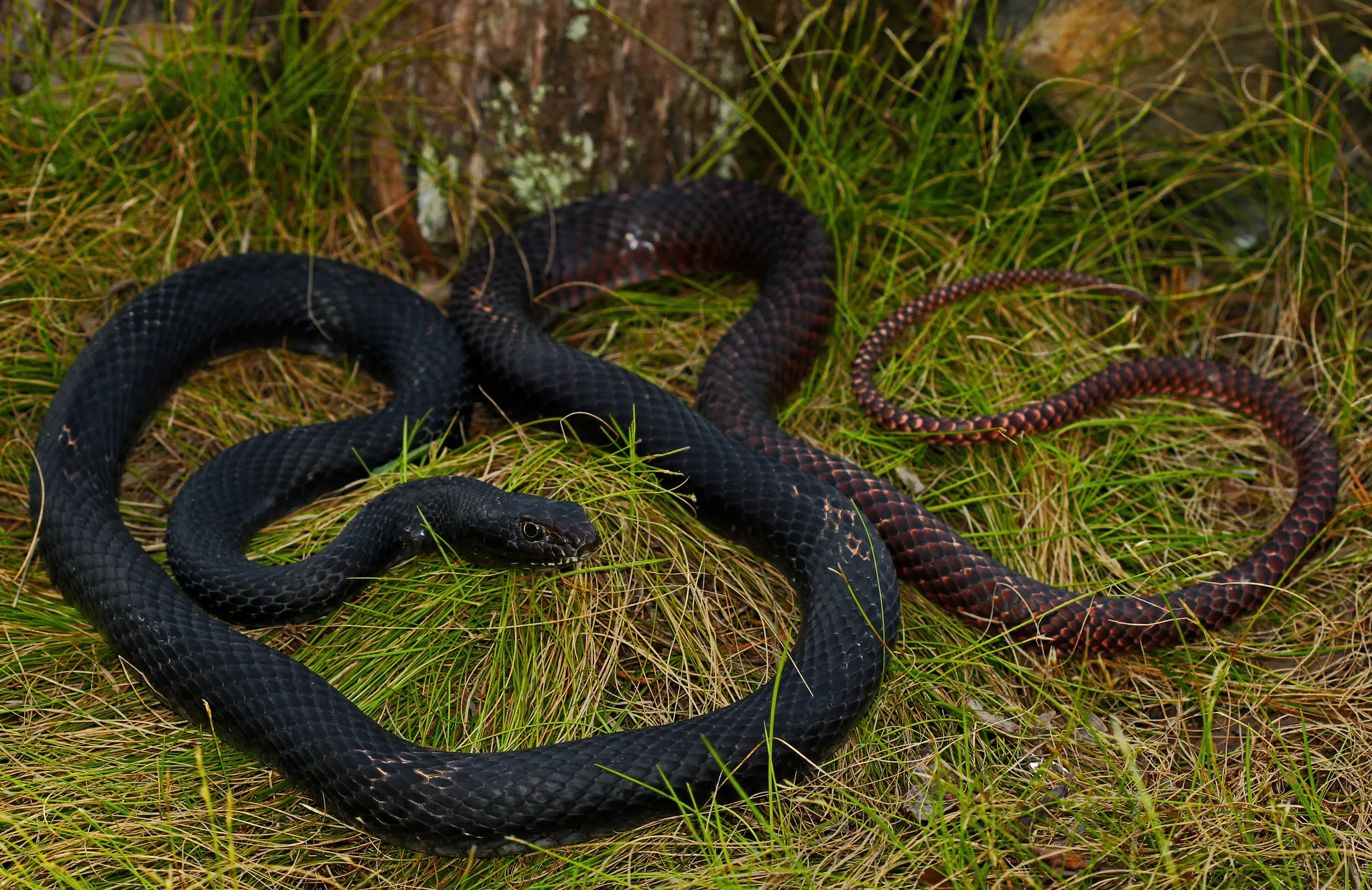
Details:
Scientific Name: Coluber flagellum
Length: Can exceed 6 feet in length
Coloration: Variable, often solid brown, reddish-brown, or black with lighter scales on the underside
Diet: Feeds primarily on small mammals, birds, and lizards
Ecological Importance:
Rodent control: Helps regulate populations of rodents, which can impact vegetation and other wildlife
Predator-prey dynamics: Serves as prey for larger predators, contributing to energy transfer within the ecosystem
Habitat indicator: Presence can indicate the health of grassland and desert ecosystems
Adaptations to New Mexico Environment:
Speed and agility: Agile movements allow it to pursue and capture fast-moving prey in open habitats like deserts and grasslands
Diurnal activity: Active during the day, utilizing sunlight for thermoregulation and hunting
Defense mechanisms: May hiss loudly, vibrate its tail, or strike if threatened, deterring potential predators and humans
8. Long-nosed Snake
Details:
Scientific Name: Rhinocheilus lecontei
Length: Can reach up to 3 feet in length
Coloration: Reddish-brown or pinkish-brown with black or dark brown blotches
Diet: Feeds primarily on lizards, especially fence lizards, but also consumes small mammals and birds
Ecological Importance:
Lizard control: Helps regulate populations of lizards, which can impact insect populations and plant diversity
Prey for predators: Serves as food for larger snakes, birds, and mammals, contributing to food webs
Habitat indicator: Presence can indicate the health of desert and grassland ecosystems
Adaptations to New Mexico Environment:
Burrowing behavior: Utilizes burrows or crevices in rocks for shelter and protection from extreme temperatures
Nocturnal activity: Active primarily at night to avoid predators and regulate body temperature in the hot desert climate
Camouflage: Blends into desert habitats with its coloration and pattern, aiding in hunting and avoiding predators
9. Striped Whipsnake
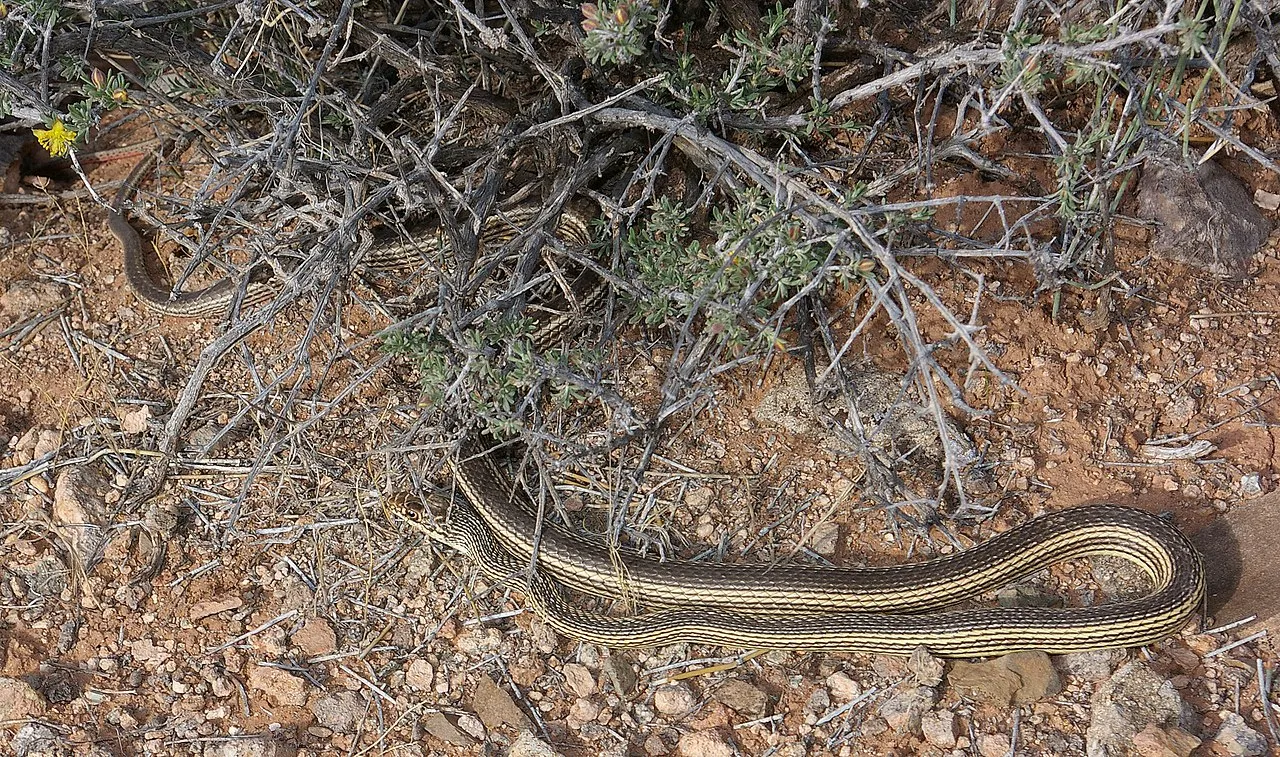
Details:
Scientific Name: Masticophis taeniatus
Length: Can exceed 4 feet in length
Coloration: Grayish-brown with longitudinal stripes along its body
Diet: Feeds primarily on lizards, small mammals, birds, and insects
Ecological Importance:
Lizard control: Helps regulate populations of lizards, which can impact insect populations and plant diversity
Predator-prey dynamics: Serves as prey for larger predators, contributing to energy transfer within the ecosystem
Habitat indicator: Presence can indicate the health of desert and grassland ecosystems
Adaptations to New Mexico Environment:
Speed and agility: Agile movements allow it to pursue and capture fast-moving prey in open habitats like deserts and grasslands
Diurnal activity: Active during the day, utilizing sunlight for thermoregulation and hunting
Camouflage: Blends into desert habitats with its coloration and pattern, aiding in hunting and avoiding predators
10. Plain-bellied Water Snake
Details:
Scientific Name: Nerodia erythrogaster
Length: Can reach up to 3 feet in length
Coloration: Variable, ranging from olive-brown to dark brown with a plain underside
Habitat: Found near bodies of water such as rivers, streams, and ponds
Ecological Importance:
Aquatic ecosystem balance: Feeds on fish, amphibians, and aquatic invertebrates, helping to maintain balance within freshwater ecosystems
Prey for predators: Serves as food for birds of prey, large fish, and mammals, contributing to energy transfer within the ecosystem
Wetland indicator: Presence can indicate the health of wetland habitats
Adaptations to New Mexico Environment:
Aquatic lifestyle: Well-adapted for swimming and hunting in aquatic environments, with streamlined bodies and keeled scales for efficient movement
Thermal regulation: Able to regulate body temperature by moving between water and land habitats, avoiding extreme temperatures
Camouflage: Blends into aquatic vegetation and muddy substrates with its coloration, aiding in hunting and avoiding predators
11. Sonora
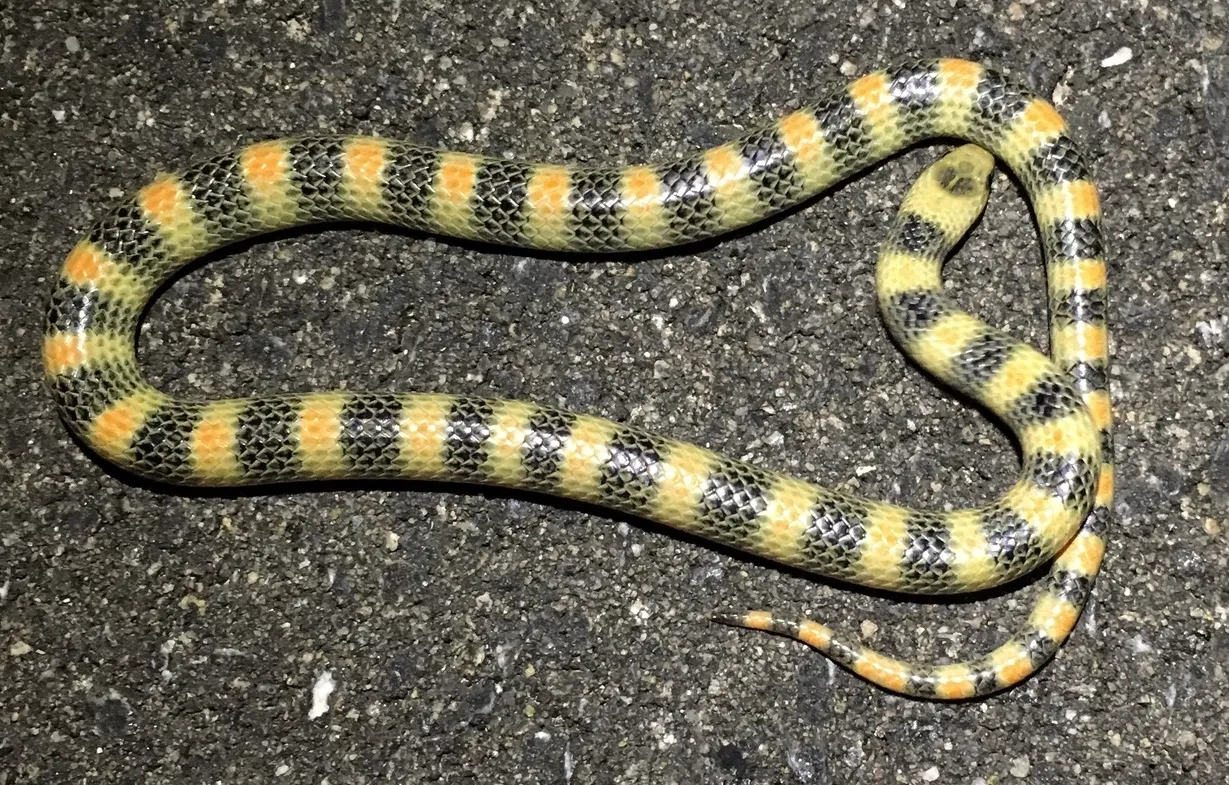
Details:
Scientific Name: Sonora semiannulata
Length: Typically 2-3 feet in length
Coloration: Light brown or grayish with dark brown or black blotches along its back
Habitat: Found in a variety of habitats including deserts, grasslands, and rocky hillsides
Ecological Importance:
Rodent control: Helps regulate populations of rodents, which can impact vegetation and other wildlife
Prey for predators: Serves as food for larger snakes, birds, and mammals, contributing to food webs
Habitat indicator: Presence can indicate the health of desert and grassland ecosystems
Adaptations to New Mexico Environment:
Nocturnal behavior: Active primarily at night to avoid predators and regulate body temperature in the hot desert climate
Burrowing: Utilizes burrows or crevices in rocks for shelter and protection from extreme temperatures
Camouflage: Blends into desert habitats with its coloration and pattern, aiding in hunting and avoiding predators
12. Western Terrestrial Garter Snake
Details:
Scientific Name: Thamnophis elegans
Length: Can reach up to 3 feet in length
Coloration: Variable, ranging from greenish-gray to brown with longitudinal stripes along its body
Habitat: Found in a variety of terrestrial habitats including grasslands, woodlands, and meadows
Ecological Importance:
Amphibian control: Feeds on amphibians such as frogs and tadpoles, helping to regulate their populations
Prey for predators: Serves as food for birds of prey, larger snakes, and mammals, contributing to energy transfer within the ecosystem
Habitat indicator: Presence can indicate the health of riparian and terrestrial ecosystems
Adaptations to New Mexico Environment:
Semi-aquatic lifestyle: Often found near water sources such as streams, ponds, and marshes, where it hunts for prey and seeks refuge
Thermoregulation: Basks in sunlight to regulate body temperature, especially in cooler environments or during the morning hours
Camouflage: Blends into terrestrial habitats with its coloration and pattern, aiding in hunting and avoiding predators
13. Western Hognose Snake
Details:
Scientific Name: Heterodon nasicus
Length: Typically 1-2 feet in length
Coloration: Variable, ranging from grayish-brown to reddish-brown with darker blotches or speckling
Habitat: Found in a variety of habitats including grasslands, deserts, and sandy areas
Ecological Importance:
Amphibian control: Feeds on amphibians such as toads and frogs, helping to regulate their populations
Prey for predators: Serves as food for birds of prey, larger snakes, and mammals, contributing to energy transfer within the ecosystem
Habitat indicator: Presence can indicate the health of grassland and desert ecosystems
Adaptations to New Mexico Environment:
Defensive behaviors: When threatened, may flatten its head, hiss loudly, and even play dead to deter predators
Burrowing: Utilizes its upturned snout to burrow into loose soil or sand, seeking shelter from extreme temperatures and predators
Camouflage: Blends into sandy or grassy habitats with its coloration and pattern, aiding in hunting and avoiding predators
14. California Kingsnake
Details:
Scientific Name: Lampropeltis californiae
Length: Can reach up to 4-5 feet in length
Coloration: Black or dark brown with white or cream-colored bands or stripes
Habitat: Found in a variety of habitats including woodlands, grasslands, and chaparral areas
Ecological Importance:
Rodent control: Helps regulate populations of rodents, which can impact vegetation and other wildlife
Prey for predators: Serves as food for birds of prey, larger snakes, and mammals, contributing to energy transfer within the ecosystem
Habitat indicator: Presence can indicate the health of terrestrial ecosystems
Adaptations to New Mexico Environment:
Camouflage: Blends into diverse habitats with its coloration and pattern, aiding in hunting and avoiding predators
Nocturnal activity: Active primarily at night to avoid predators and regulate body temperature in the hot desert climate
Defensive mimicry: May mimic the rattling sound of rattlesnakes by vibrating its tail when threatened, deterring potential predators
15. Glossy Snake
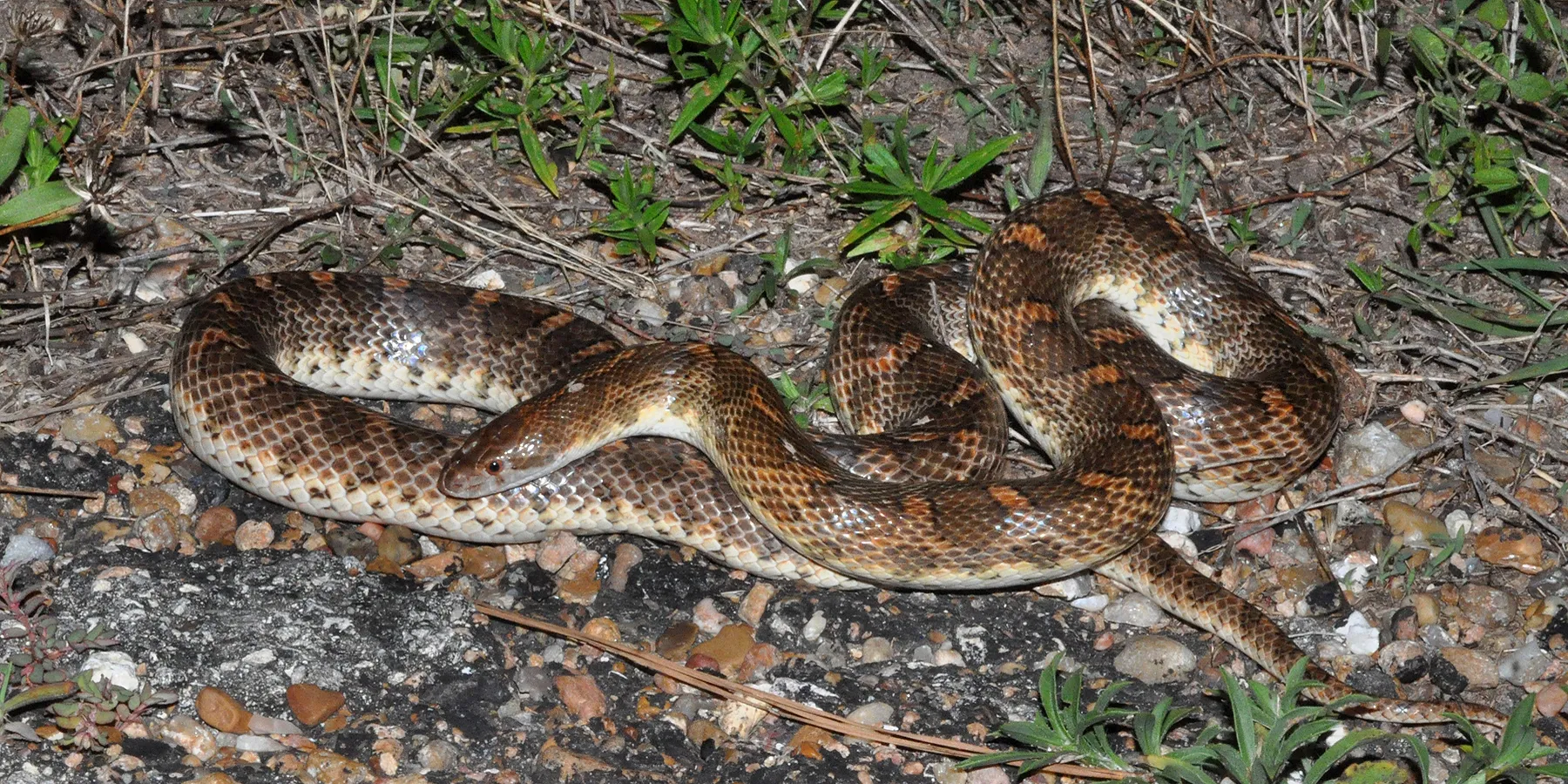
Details:
Scientific Name: Arizona elegans
Length: Can reach up to 2-3 feet in length
Coloration: Light brown or tan with dark blotches or bands along its back
Habitat: Found in a variety of habitats including deserts, grasslands, and rocky slopes
Ecological Importance:
Rodent control: Helps regulate populations of rodents, which can impact vegetation and other wildlife
Prey for predators: Serves as food for birds of prey, larger snakes, and mammals, contributing to energy transfer within the ecosystem
Habitat indicator: Presence can indicate the health of desert and grassland ecosystems
Adaptations to New Mexico Environment:
Camouflage: Blends into desert habitats with its coloration and pattern, aiding in hunting and avoiding predators
Burrowing behavior: Able to burrow into loose soil or sand for shelter and protection from extreme temperatures and predators
Nocturnal activity: Active primarily at night to avoid predators and regulate body temperature in the hot desert climate
16. Smooth Green Snake
Details:
Scientific Name: Opheodrys vernalis
Length: Typically 1-2 feet in length
Coloration: Bright green with a yellow or white underside
Habitat: Found in grasslands, meadows, and wetland areas
Ecological Importance:
Insect control: Feeds primarily on insects such as grasshoppers, caterpillars, and crickets, helping to control insect populations
Prey for predators: Serves as food for birds of prey, larger snakes, and mammals, contributing to energy transfer within the ecosystem
Habitat indicator: Presence can indicate the health of grassland and wetland ecosystems
Adaptations to New Mexico Environment:
Arboreal lifestyle: Often found climbing in vegetation, utilizing its slender body and prehensile tail to navigate branches and foliage
Camouflage: Blends into grassy and leafy habitats with its bright green coloration, aiding in hunting and avoiding predators
Non-venomous: Relies on speed, agility, and camouflage for defense rather than venomous bites
17. Gray-banded Kingsnake
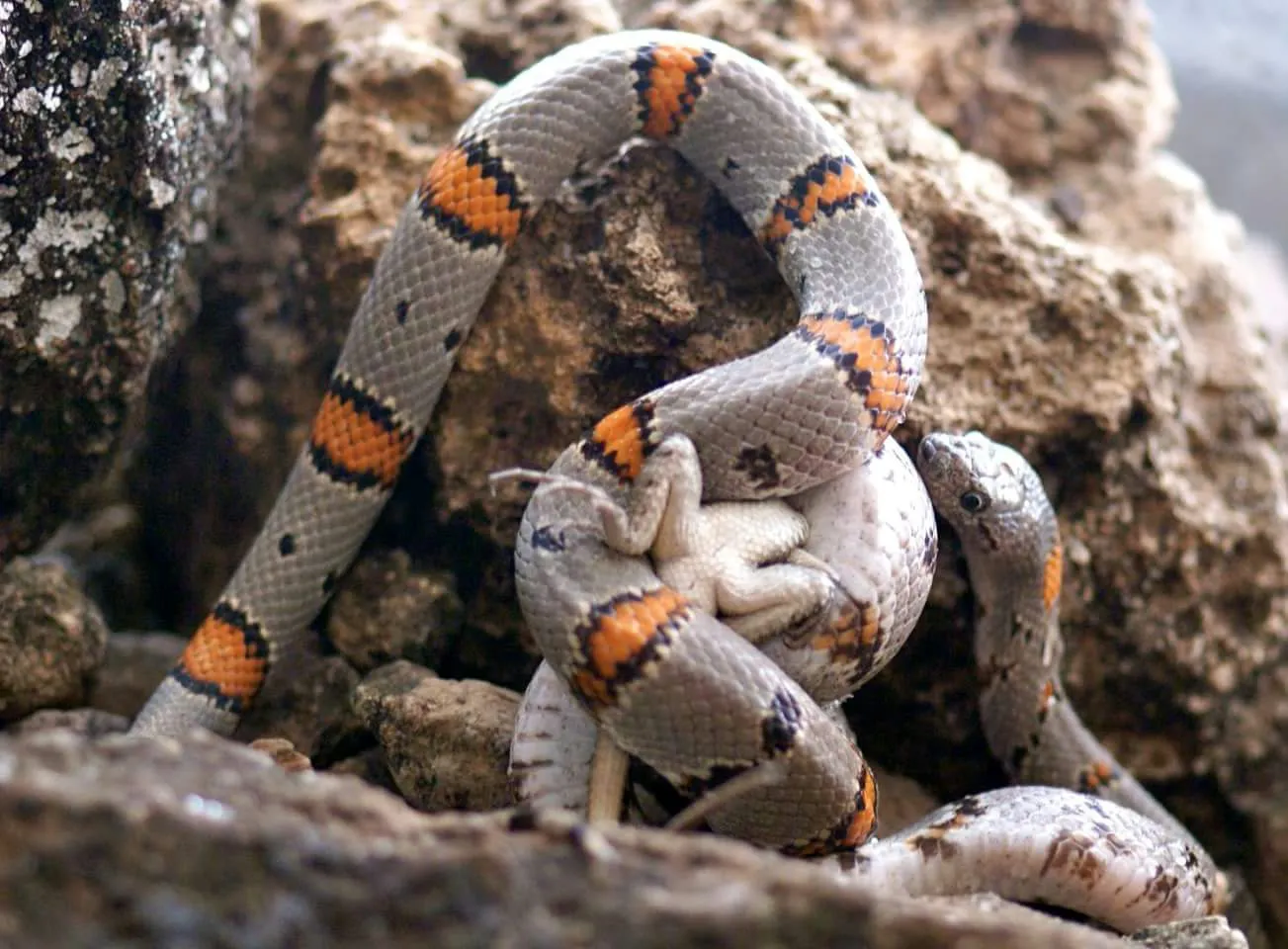
Details:
Scientific Name: Lampropeltis alterna
Length: Can reach up to 3-4 feet in length
Coloration: Black or dark brown with light gray or white bands or stripes
Habitat: Found in a variety of habitats including rocky hillsides, desert scrubland, and grasslands
Ecological Importance:
Rodent control: Helps regulate populations of rodents, which can impact vegetation and other wildlife
Prey for predators: Serves as food for birds of prey, larger snakes, and mammals, contributing to energy transfer within the ecosystem
Habitat indicator: Presence can indicate the health of rocky and desert ecosystems
Adaptations to New Mexico Environment:
Camouflage: Blends into diverse habitats with its coloration and pattern, aiding in hunting and avoiding predators
Nocturnal activity: Active primarily at night to avoid predators and regulate body temperature in the hot desert climate
Defensive mimicry: May mimic the rattling sound of rattlesnakes by vibrating its tail when threatened, deterring potential predators
18. Centipede Snake
Details:
Scientific Name: Tantilla spp.
Length: Usually less than 12 inches in length
Coloration: Brown or gray with darker markings or speckles
Habitat: Found in various habitats including deserts, grasslands, and woodlands
Ecological Importance:
Insect control: Feeds primarily on small invertebrates such as centipedes, spiders, and insects, helping to control their populations
Prey for predators: Serves as food for birds, larger snakes, and small mammals, contributing to energy transfer within the ecosystem
Habitat indicator: Presence can indicate the health of terrestrial ecosystems
Adaptations to New Mexico Environment:
Nocturnal activity: Active primarily at night to avoid predators and regulate body temperature in the hot desert climate
Burrowing behavior: Utilizes loose soil or leaf litter for shelter and protection from predators
Small size: Adapted to navigate narrow spaces and burrows in search of prey and shelter
19. Trans-pecos Rat Snake
Details:
Scientific Name: Bogertophis subocularis
Length: Can reach up to 4-5 feet in length
Coloration: Brown or gray with dark blotches or bands along its back
Habitat: Found in a variety of habitats including deserts, grasslands, and rocky slopes
Ecological Importance:
Rodent control: Helps regulate populations of rodents, which can impact vegetation and other wildlife
Prey for predators: Serves as food for birds of prey, larger snakes, and mammals, contributing to energy transfer within the ecosystem
Habitat indicator: Presence can indicate the health of desert and grassland ecosystems
Adaptations to New Mexico Environment:
Camouflage: Blends into diverse habitats with its coloration and pattern, aiding in hunting and avoiding predators
Nocturnal activity: Active primarily at night to avoid predators and regulate body temperature in the hot desert climate
Arboreal behavior: Capable of climbing trees and shrubs in search of prey and shelter
20. Eastern Racer
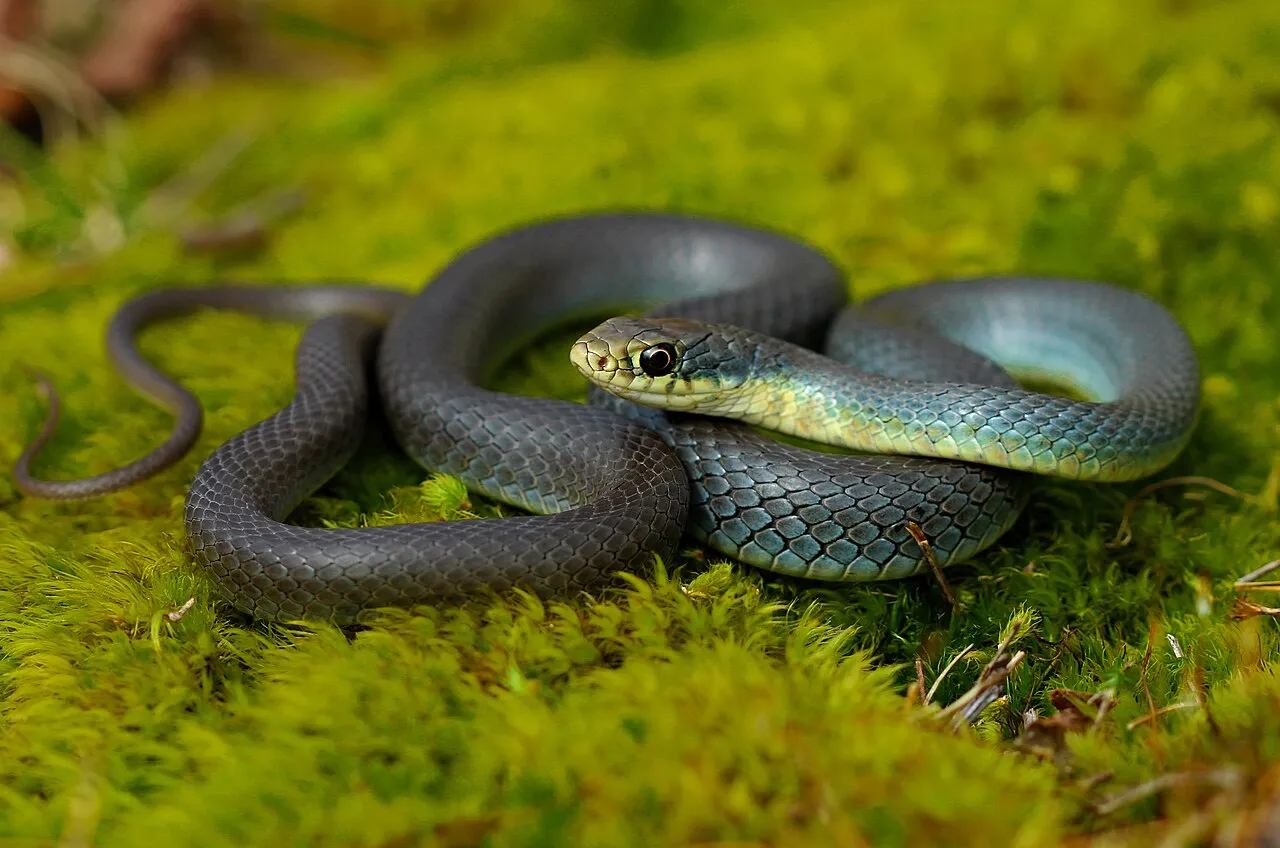
Details:
Scientific Name: Coluber constrictor
Length: Can exceed 4 feet in length
Coloration: Variable, often greenish-gray or brown with lighter scales on the underside
Habitat: Found in a variety of habitats including woodlands, grasslands, and agricultural fields
Ecological Importance:
Rodent control: Helps regulate populations of rodents, which can impact vegetation and other wildlife
Prey for predators: Serves as food for birds of prey, larger snakes, and mammals, contributing to energy transfer within the ecosystem
Habitat indicator: Presence can indicate the health of terrestrial ecosystems
Adaptations to New Mexico Environment:
Speed and agility: Agile movements allow it to pursue and capture fast-moving prey in open habitats like grasslands and agricultural fields
Diurnal activity: Active during the day, utilizing sunlight for thermoregulation and hunting
Defensive behavior: May flee rapidly when threatened, utilizing its speed to escape predators
21. Texas Lyre Snake
Details:
Scientific Name: Trimorphodon biscutatus
Length: Can reach up to 3-4 feet in length
Coloration: Gray or brown with dark blotches or bands along its back, often with a distinctive lyre-shaped mark on the head
Habitat: Found in a variety of habitats including deserts, rocky hillsides, and canyons
Ecological Importance:
Rodent control: Helps regulate populations of rodents, which can impact vegetation and other wildlife
Prey for predators: Serves as food for birds of prey, larger snakes, and mammals, contributing to energy transfer within the ecosystem
Habitat indicator: Presence can indicate the health of desert and rocky ecosystems
Adaptations to New Mexico Environment:
Camouflage: Blends into diverse habitats with its coloration and pattern, aiding in hunting and avoiding predators
Nocturnal activity: Active primarily at night to avoid predators and regulate body temperature in the hot desert climate
Arboreal behavior: Capable of climbing trees and rock formations in search of prey and shelter
22. Eastern Massasauga
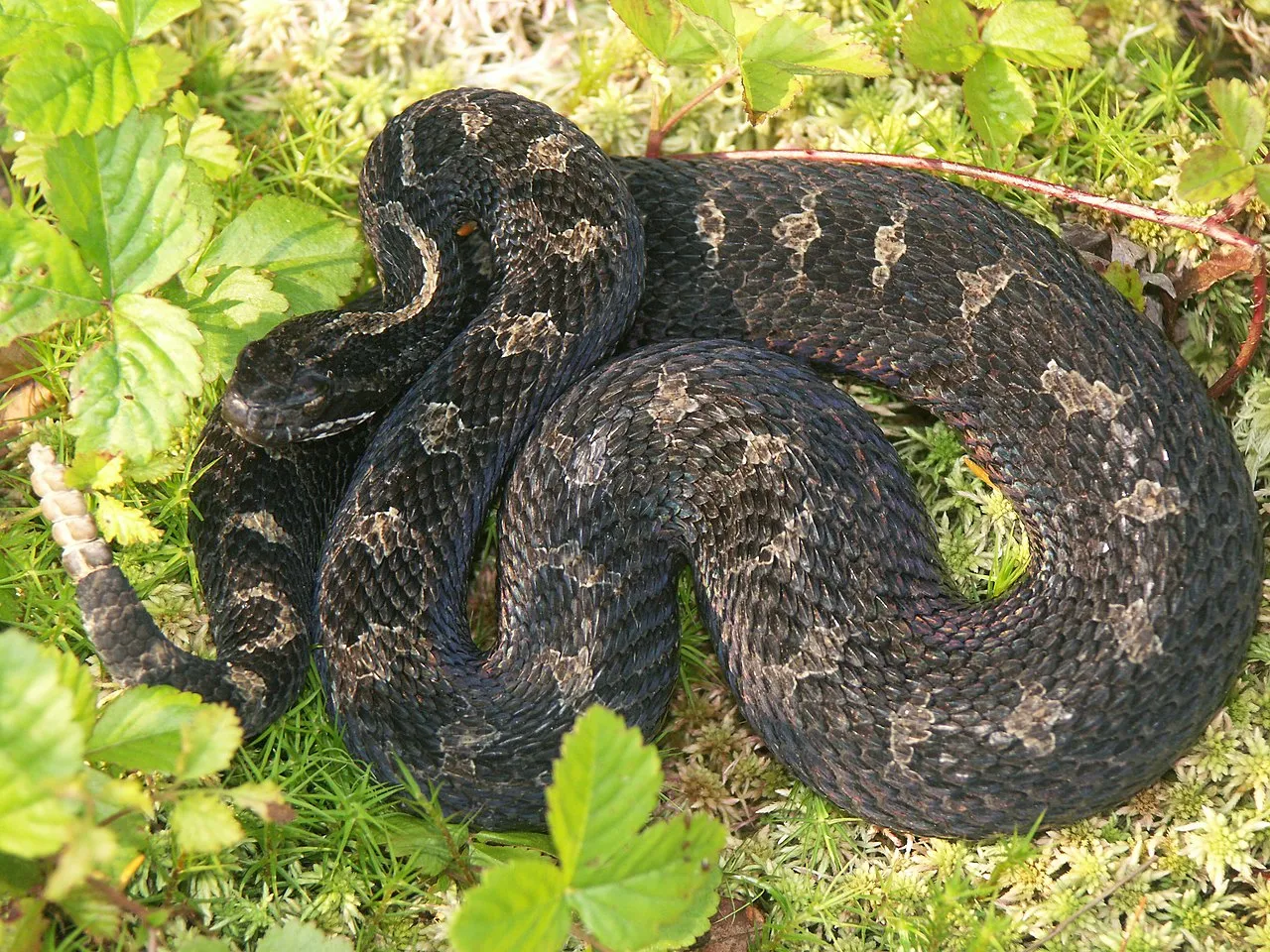
Details:
Scientific Name: Sistrurus catenatus
Length: Typically 1-2 feet in length
Coloration: Gray or brown with dark blotches or bands along its back, often with a distinctive rattlesnake-like appearance
Habitat: Found in wetland habitats such as marshes, swamps, and grassy meadows
Ecological Importance:
Wetland ecosystem balance: Plays a role in regulating populations of small mammals and amphibians within wetland ecosystems
Prey for predators: Serves as food for birds, larger snakes, and mammals, contributing to energy transfer within the ecosystem
Habitat indicator: Presence can indicate the health of wetland habitats
Adaptations to New Mexico Environment:
Limited distribution: While not typically found in New Mexico, it may inhabit similar habitats in neighboring regions with suitable wetland environments
Camouflage: Blends into grassy and marshy habitats with its coloration and pattern, aiding in hunting and avoiding predators
Defensive behavior: May use its rattlesnake-like appearance and behavior to deter potential predators, despite being non-venomous
23. Western Ribbon Snake
Details:
Scientific Name: Thamnophis proximus
Length: Can reach up to 2-3 feet in length
Coloration: Gray or brown with three yellow or white stripes running along its body
Habitat: Found near water sources such as streams, ponds, and marshes
Ecological Importance:
Aquatic ecosystem balance: Feeds on fish, amphibians, and aquatic invertebrates, helping to maintain balance within freshwater ecosystems
Prey for predators: Serves as food for birds, larger snakes, and mammals, contributing to energy transfer within the ecosystem
Wetland indicator: Presence can indicate the health of wetland habitats
Adaptations to New Mexico Environment:
Aquatic lifestyle: Well-adapted for swimming and hunting in aquatic environments, with streamlined bodies and keeled scales for efficient movement
Semi-aquatic behavior: Often found basking near water sources or hunting along the edges of streams and ponds
Camouflage: Blends into grassy and marshy habitats with its coloration and pattern, aiding in hunting and avoiding predators
24. Chihuahuan Nightsnake
Details:
Scientific Name: Hypsiglena jani
Length: Typically less than 2 feet in length
Coloration: Gray or brown with dark blotches or bands along its back
Habitat: Found in a variety of habitats including deserts, grasslands, and rocky slopes
Ecological Importance:
Rodent control: Helps regulate populations of rodents, which can impact vegetation and other wildlife
Prey for predators: Serves as food for birds, larger snakes, and mammals, contributing to energy transfer within the ecosystem
Habitat indicator: Presence can indicate the health of desert and grassland ecosystems
Adaptations to New Mexico Environment:
Nocturnal activity: Active primarily at night to avoid predators and regulate body temperature in the hot desert climate
Burrowing behavior: Utilizes loose soil or rocky crevices for shelter and protection from extreme temperatures and predators
Camouflage: Blends into diverse habitats with its coloration and pattern, aiding in hunting and avoiding predators
25. Bullsnake
Details:
Scientific Name: Pituophis catenifer sayi
Length: Can reach up to 6 feet in length
Coloration: Yellow or cream-colored with dark brown or black blotches along its back
Habitat: Found in a variety of habitats including grasslands, prairies, and agricultural fields
Ecological Importance:
Rodent control: Helps regulate populations of rodents, which can impact vegetation and other wildlife
Prey for predators: Serves as food for birds of prey, larger snakes, and mammals, contributing to energy transfer within the ecosystem
Habitat indicator: Presence can indicate the health of grassland and terrestrial ecosystems
Adaptations to New Mexico Environment:
Camouflage: Blends into grassy habitats with its coloration and pattern, aiding in hunting and avoiding predators
Defensive behavior: May hiss loudly, vibrate its tail, and flatten its head to deter potential predators, despite being non-venomous
Diurnal activity: Active during the day, utilizing sunlight for thermoregulation and hunting
26. Sonoran Gopher Snake
Details:
Scientific Name: Pituophis catenifer affinis
Length: Can reach up to 6 feet in length
Coloration: Yellow or tan with dark blotches along its back
Habitat: Found in a variety of habitats including deserts, grasslands, and scrublands
Ecological Importance:
Rodent control: Helps regulate populations of rodents, which can impact vegetation and other wildlife
Prey for predators: Serves as food for birds of prey, larger snakes, and mammals, contributing to energy transfer within the ecosystem
Habitat indicator: Presence can indicate the health of desert and grassland ecosystems
Adaptations to New Mexico Environment:
Camouflage: Blends into diverse habitats with its coloration and pattern, aiding in hunting and avoiding predators
Defensive behavior: May hiss loudly, vibrate its tail, and flatten its head to deter potential predators, despite being non-venomous
Burrowing behavior: Capable of entering rodent burrows to hunt for prey and seek shelter from extreme temperatures
27. Night Snake
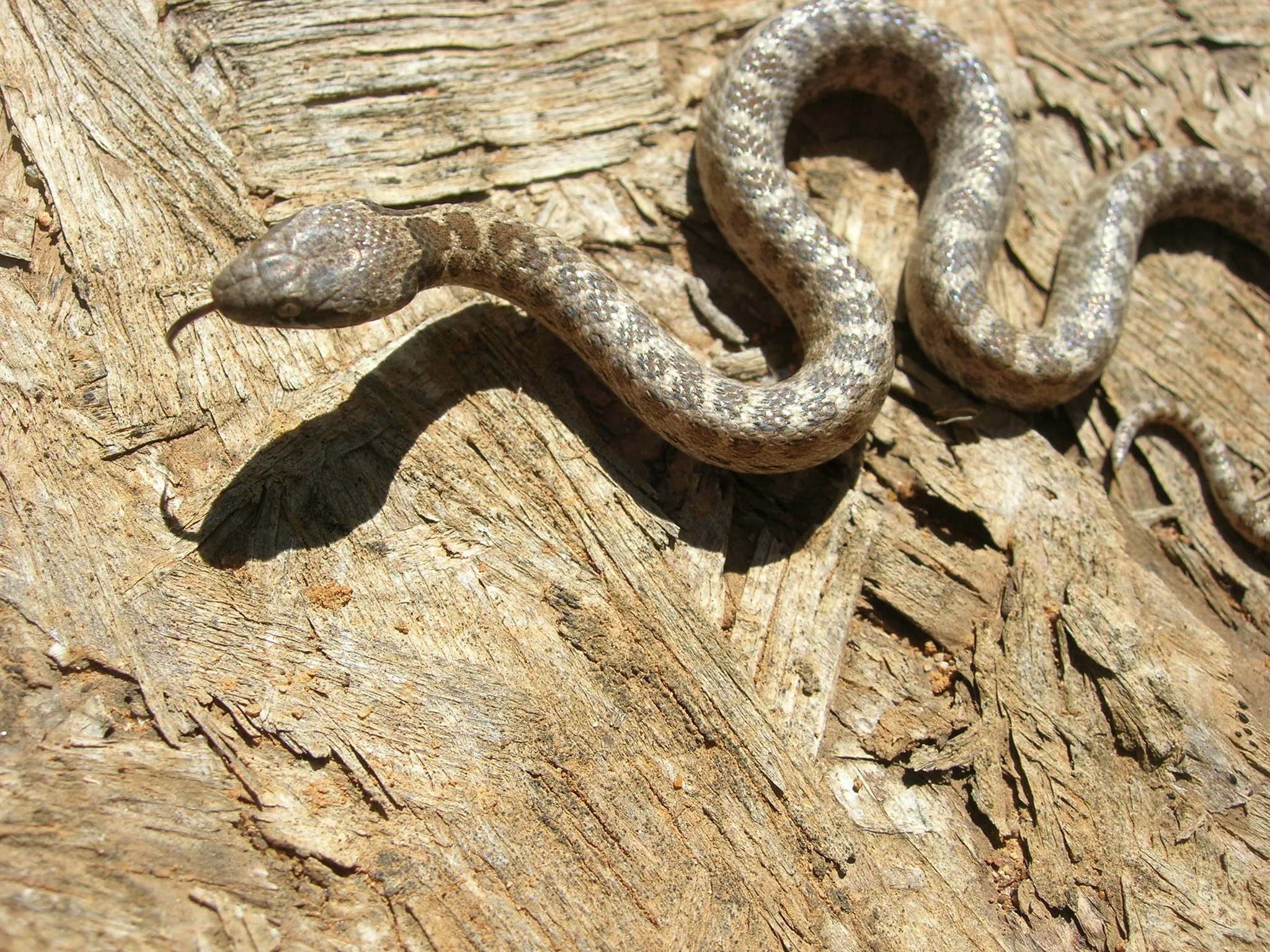
Details:
Scientific Name: Hypsiglena torquata
Length: Typically less than 2 feet in length
Coloration: Gray or brown with dark blotches or bands along its back
Habitat: Found in a variety of habitats including deserts, rocky slopes, and woodlands
Ecological Importance:
Rodent control: Helps regulate populations of rodents, which can impact vegetation and other wildlife
Prey for predators: Serves as food for birds, larger snakes, and mammals, contributing to energy transfer within the ecosystem
Habitat indicator: Presence can indicate the health of desert and terrestrial ecosystems
Adaptations to New Mexico Environment:
Nocturnal activity: Active primarily at night to avoid predators and regulate body temperature in the hot desert climate
Burrowing behavior: Utilizes loose soil or rocky crevices for shelter and protection from extreme temperatures and predators
Camouflage: Blends into diverse habitats with its coloration and pattern, aiding in hunting and avoiding predators
28. Texas Blind Snake
Details:
Scientific Name: Leptotyphlops dulcis
Length: Typically less than 1 foot in length
Coloration: Pinkish or purplish-brown with a shiny appearance
Habitat: Found in a variety of habitats including deserts, grasslands, and woodlands
Ecological Importance:
Soil health: Helps aerate and enrich soil through its burrowing activity, promoting the health of plant roots and soil microorganisms
Prey for predators: Serves as food for birds, larger snakes, and mammals, contributing to energy transfer within the ecosystem
Habitat indicator: Presence can indicate the health of terrestrial ecosystems
Adaptations to New Mexico Environment:
Burrowing behavior: Specialized for a subterranean lifestyle, utilizing its small size and pointed head to navigate soil and leaf litter
Nocturnal activity: Active primarily at night to avoid predators and regulate body temperature in the hot desert climate
Reduced eyesight: Adapted for a primarily underground existence, with vestigial eyes or no eyes at all
29. Great Basin Gopher Snake
Details:
Scientific Name: Pituophis catenifer deserticola
Length: Can reach up to 6 feet in length
Coloration: Yellow or tan with dark blotches along its back
Habitat: Found in a variety of habitats including deserts, grasslands, and shrublands
Ecological Importance:
Rodent control: Helps regulate populations of rodents, which can impact vegetation and other wildlife
Prey for predators: Serves as food for birds of prey, larger snakes, and mammals, contributing to energy transfer within the ecosystem
Habitat indicator: Presence can indicate the health of desert and grassland ecosystems
Adaptations to New Mexico Environment:
Camouflage: Blends into diverse habitats with its coloration and pattern, aiding in hunting and avoiding predators
Defensive behavior: May hiss loudly, vibrate its tail, and flatten its head to deter potential predators, despite being non-venomous
Burrowing behavior: Capable of entering rodent burrows to hunt for prey and seek shelter from extreme temperatures
